Active Region Mode Control for High-Power, Low-Linewidth Broadened Semiconductor Optical Amplifiers for Light Detection and Ranging
Abstract
1. Introduction
2. Device Structure Design and Preparation Process
2.1. The Comprehensive Design of the Device’s Structure
2.2. The Design of the Epitaxial Structure
2.3. The Design of the Active Region Mode Modulation
2.4. The Preparation of the Device
3. Device Performance Testing and Analysis
3.1. The Configuration of the Test Platform
3.2. Testing for the Spectra of Amplified Spontaneous Emission
3.3. Testing for Single Wavelength Output Power and Gain
3.4. Testing for the Amplified Spectrum and Gain Curve
3.5. Testing for Line-Width Broadening Characteristics
3.6. Testing for Polarization Characteristics
4. Discussion
5. Conclusions
Author Contributions
Funding
Institutional Review Board Statement
Informed Consent Statement
Data Availability Statement
Conflicts of Interest
References
- Chen, J.-D.; Ho, H.-L.; Tsay, H.-L.; Lee, Y.-L.; Yang, C.-A.; Wu, K.-W.; Sun, J.-L.; Tsai, D.-J.; Lin, F.-Y. 3D chaos lidar system with a pulsed master oscillator power amplifier scheme. Opt. Express 2021, 29, 27871–27881. [Google Scholar] [CrossRef] [PubMed]
- Niclass, C.; Ito, K.; Soga, M.; Matsubara, H.; Aoyagi, I.; Kato, S.; Kagami, M. Design and characterization of a 256x64-pixel single-photon imager in CMOS for a MEMS-based laser scanning time-of-flight sensor. Opt. Express 2012, 20, 11863–11881. [Google Scholar] [CrossRef] [PubMed]
- McCarthy, A.; Ren, X.; Della Frera, A.; Gemmell, N.R.; Krichel, N.J.; Scarcella, C.; Ruggeri, A.; Tosi, A.; Buller, G.S. Kilometer-range depth imaging at 1550 nm wavelength using an InGaAs/InP single-photon avalanche diode detector. Opt. Express 2013, 21, 22098–22113. [Google Scholar] [CrossRef] [PubMed]
- Tang, H.; Yang, C.; Qin, L.; Liang, L.; Lei, Y.; Jia, P.; Chen, Y.; Wang, Y.; Song, Y.; Qiu, C.; et al. A Review of High-Power Semiconductor Optical Amplifiers in the 1550 nm Band. Sensors 2023, 23, 7326. [Google Scholar] [CrossRef] [PubMed]
- Loh, W.; Plant, J.J.; Klamkin, J.; Donnelly, J.P.; O’Donnell, F.J.; Ram, R.J.; Juodawlkis, P.W. Noise Figure of Watt-Class Ultralow-Confinement Semiconductor Optical Amplifiers. IEEE J. Quantum Electron. 2011, 47, 66–75. [Google Scholar] [CrossRef]
- Faugeron, M.; Vilera, M.; Krakowski, M.; Robert, Y.; Vinet, E.; Primiani, P.; Le Goëc, J.-P.; Parillaud, O.; Pérez-Serrano, A.; Tijero, J.M.G.; et al. High Power Three-Section Integrated Master Oscil-lator Power Amplifier at 1.5 μm. IEEE Photonics Technol. Lett. 2015, 27, 1449–1452. [Google Scholar] [CrossRef]
- Ogrodowski, L.; Friedmann, P.; Gilly, J.; Kelemen, M.T. Tapered Amplifiers for High-Power MOPA Setups between 750 nm and 2000 nm. In Proceedings of the Novel In-Plane Semiconductor Lasers XIX, SPIE OTO, San Francisco, CA, USA, 1–6 February 2020; Volume 11301. [Google Scholar] [CrossRef]
- Huang, D.X. Semiconductor Optical Amplifiers and Their Applications; Science Press: Beijing, China, 2012. [Google Scholar]
- Chuang, S.L. Physics of Photonic Devices; John Wiley & Sons: Hoboken, NJ, USA, 2012. [Google Scholar]
- Wong, W.P.; Chiang, K.S. Design of waveguide structures for polarization-insensitive optical amplification. IEEE J. Quantum Elect. 2000, 36, 1243–1250. [Google Scholar] [CrossRef]
- Michie, C.; Kelly, A.E.; McGeough, J.; Armstrong, I.; Andonovic, I.; Tombling, C. Polarization-Insensitive SOAs Using Strained Bulk Active Regions. J. Light. Technol. 2006, 24, 3920–3927. [Google Scholar] [CrossRef]
- Huang, L.; Yu, Y.; Tian, P.; Huang, D. Polarization-insensitive quantum-dot coupled quantum-well semiconductor optical ampli-fier. Semicond. Sci. Technol. 2009, 24, 015009. [Google Scholar] [CrossRef]
- Wilkinson, S.; Lingnau, B.; Korn, J.; Schöll, E.; Lüdge, K. Influence of Noise on the Signal Quality of Quantum-Dot Semiconductor Optical Amplifiers. IEEE J. Sel. Top. Quantum Electron. 2013, 19, 1900106. [Google Scholar] [CrossRef]
- Hein, S.; Podemski, P.; Sek, G.; Misiewicz, J.; Ridha, P.; Fiore, A.; Patriarche, G.; Hofling, S.; Forchel, A. Columnar quantum dashes for polarization insensitive semi-conductor optical amplifiers. In Proceedings of the 21st International Conference on Indium Phosphide and Related Material, Newport Beach, CA, USA, 10–14 May 2009. [Google Scholar] [CrossRef]
- Even, J.; Pedesseau, L.; Dore, F.; Boyer-Richard, S. InAs QDs on InP: Polarization insensitive SOA and non-radiative Auger pro-cesses. Opt. Quantum Electron. 2009, 40, 1233–1238. [Google Scholar] [CrossRef]
- Kaizu, T.; Kakutani, T.; Akahane, K.; Kita, T. Polarization-insensitive fiber-to-fiber gain of semiconductor optical amplifier using closely stacked InAs/GaAs quantum dots. Jpn. J. Appl. Phys. 2020, 59, 032002. [Google Scholar] [CrossRef]
- Wang, T.; Wang, Z.X.; Huang, D.X. Theoretical analysis of a tapered-rib semiconductor optical amplifier. Opt. Commun. 2002, 214, 177–185. [Google Scholar]
- Abedi, K.; Mohadesrad, E. Gain Stabilization of a Quantum-Dot Semiconductor Optical Amplifier by Introducing Tapered Waveguide Structure. In Proceedings of the Photonics Global Conference (PGC), Singapore, 13–16 December 2012. [Google Scholar]
- Mesaritakis, C.; Kapsalis, A.; Simos, H.; Simos, C.; Krakowski, M.; Krestnikov, I.; Syvridis, D. Tapered InAs/InGaAs quantum dot semiconductor optical amplifier design for enhanced gain and beam quality. Opt. Lett. 2013, 38, 2404–2406. [Google Scholar] [CrossRef] [PubMed]
- Sujecki, S.; Wykes, J.; Sewell, P.; Vukovic, A.; Benson, T.M.; Larkins, E.C.; Borruel, L.; Esquivias, I. Optical properties of tapered laser cavities. IEE Proc. Optoelectron. 2003, 150, 246–252. [Google Scholar] [CrossRef]
- Voigt, D.; Schilder, E.C.; Spreeuw, R.J.C.; van Linden van den Heuvell, H.B. Characterization of a high-power tapered semiconductor amplifier system. Appl. Phys. B Laser Opt. 2001, 72, 279–284. [Google Scholar] [CrossRef]
- Shawki, H.A.; Kotb, H.E.; Khalil, D. Narrow line width semiconductor optical amplifier based random laser. In Proceedings of the Fiber Lasers XIV—Technology and Systems, San Francisco, CA, USA, 28 January–2 February 2017. [Google Scholar] [CrossRef]
- Swertfeger, R.B.; Beil, J.A.; Misak, S.M.; Thomas, J.; Campbell, J.; Renner, D.; Mashanovitch, M.; Leisher, P.O. Direct Observation of the 2D Gain Profile in High Power Tapered Semiconductor Optical Amplifiers. In Proceedings of the 5th International Conference on Photonics, Optics and Laser Technology (PHOTOPTICS), Porto, Portugal, 27 February–1 March 2017. [Google Scholar] [CrossRef]
- Pham, C.; Van Dijk, F.; Vinet, E.; Robert, Y.; Parillaud, O.; Faugeron, M.; Garcia, M.; Larrue, A.; Rissons, A. Monolithic InP master oscillator power amplifier for free space optical transmissions at 1.5 μm. In Proceedings of the Free-Space Laser Communication and Atmospheric Propagation XXX, San Francisco, CA, USA, 29–30 January 2018. [Google Scholar] [CrossRef]
- Perez-Serrano, A.; Tijero, J.M.G.; Balle, S.; Esquivias, I. Numerical Analysis of the Modulation Dynamics in an Integrated Three-Section MOPA Using a Voltage Driven Traveling-Wave Model. IEEE J. Sel. Top. Quantum Electron. 2019, 25, 3000110. [Google Scholar] [CrossRef]
- Vilera, M.; Perez-Serrano, A.; Faugeron, M.; Tijero, J.M.G.; Krakowski, M.; van Dijk, F.; Esquivias, I. Modulation Performance of Three-Section Integrated MOPAs for Pseudorandom Lidar. IEEE Photonics Technol. Lett. 2017, 29, 1486–1489. [Google Scholar] [CrossRef]
- Beil, J.A.; Shimomoto, L.; Swertfeger, R.B.; Misak, S.M.; Campbell, J.; Thomas, J.; Renner, D.; Mashanovitch, M.; Leisher, P.O.; Liptak, R.W. Improvements to tapered semiconductor MOPA laser design and testing. In Proceedings of the High-Power Diode Laser Technology XVI, San Francisco, CA, USA, 27 January–1 February 2018. [Google Scholar] [CrossRef]
- Vilera, M.; Faugeron, M.; Pérez-Serrano, A.; Tijero, J.M.G.; Krakowski, M.; Van Dijk, F.; Esquivias, I. Three-section master oscillator power amplifier at 1.57 μm for LIDAR measurements of atmospheric carbon dioxide. In Proceedings of the Novel In-Plane Semiconductor Lasers XV, San Francisco, CA, USA, 15–18 February 2016. [Google Scholar] [CrossRef]
- Faugeron, M.; Vilera, M.; Perez-Serrano, A.; Tijero, J.M.G.; Esquivias, I.; Krakowski, M.; van Dijk, F. Monolithic Integration of a High Power Semiconductor Master Oscillator Power Amplifier. In Proceedings of the IEEE Photonics Conference, Reston, VA, USA, 4–8 October 2015. [Google Scholar]
- Hou, L.P.; Haji, M.; Akbar, J.; Marsh, J.H. Narrow linewidth laterally coupled 1.55 μm AlGaInAs/InP distributed feedback lasers integrated with a curved tapered semiconductor optical amplifier. Opt. Lett. 2012, 37, 4525–4527. [Google Scholar] [CrossRef] [PubMed]
- Li, X.; Liang, L.; Wang, L.J.; Qin, L.; Chen, Y.Y.; Wang, Y.B.; Song, Y.; Lei, Y.X.; Jia, P.; Zeng, Y.G.; et al. Monolithic Integrated Semiconductor Optical Amplifier with Broad Spectrum, High Power, and Small Linewidth Expansion. IEEE Access 2021, 9, 98863–98873. [Google Scholar] [CrossRef]





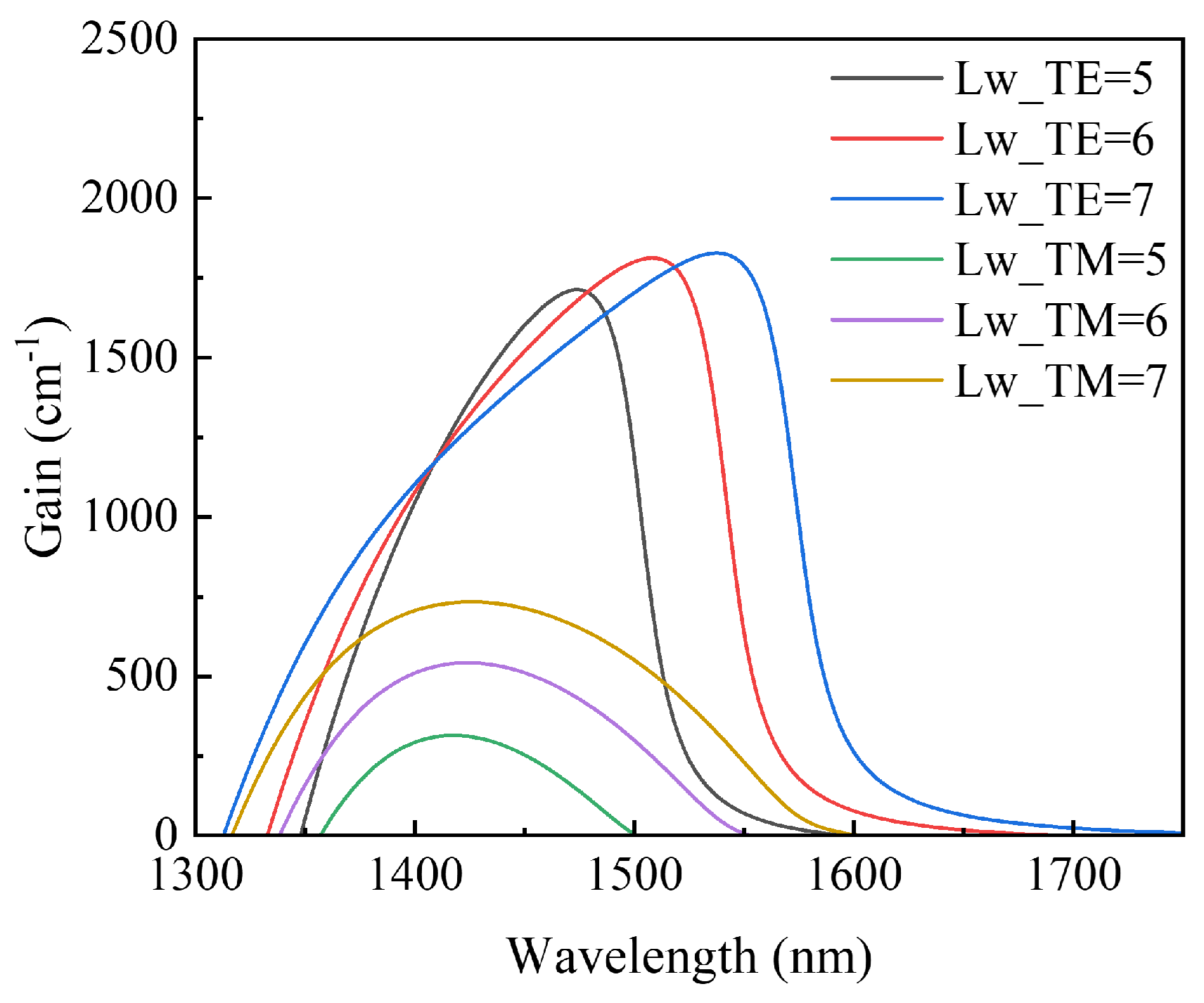

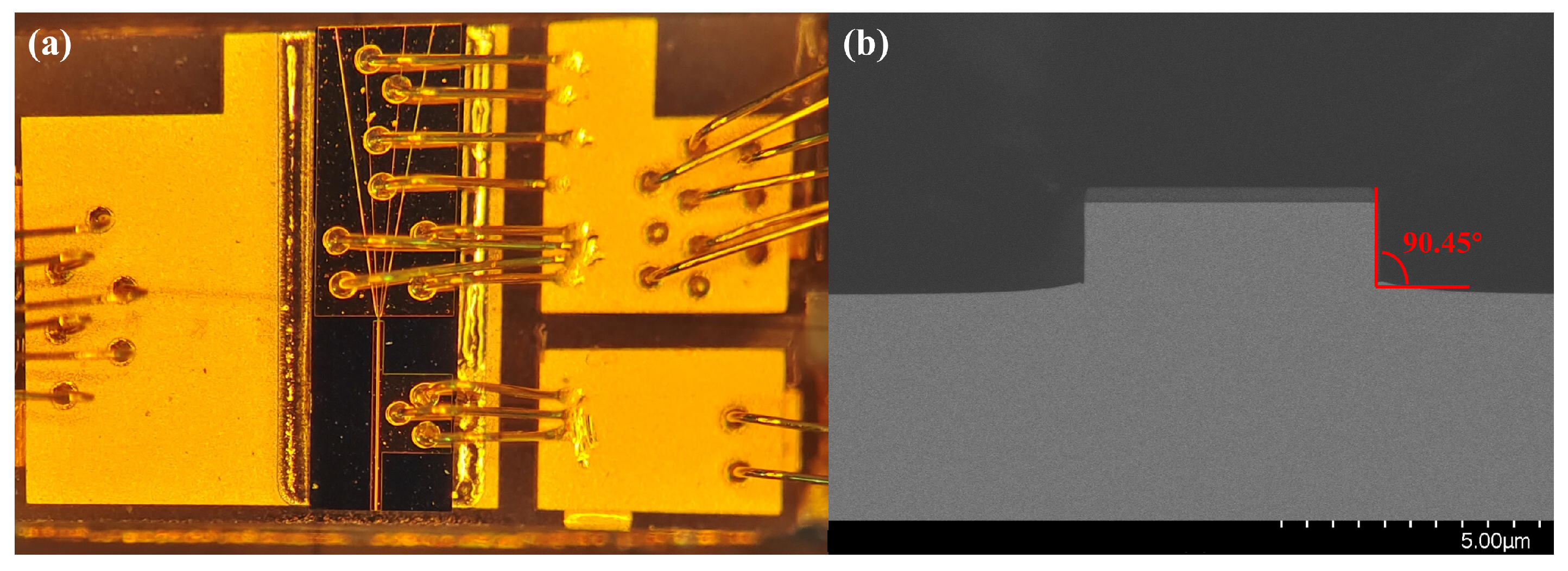




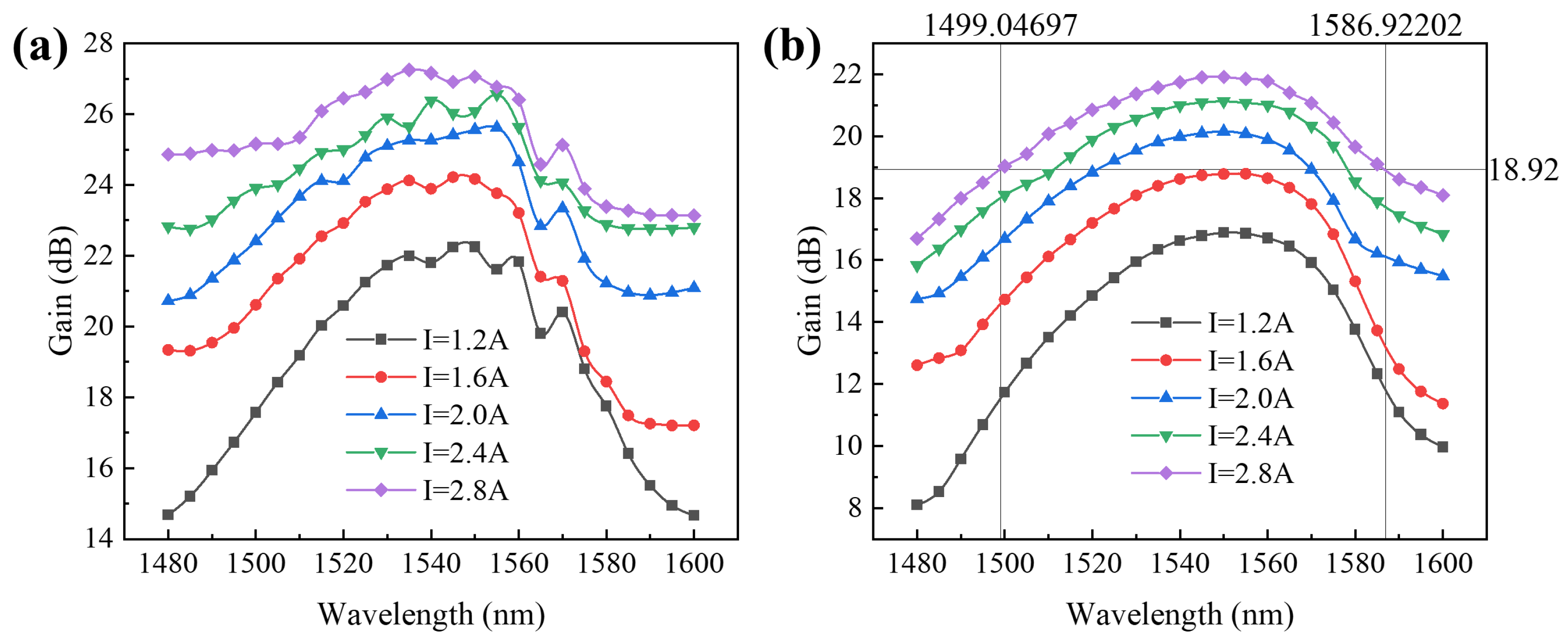


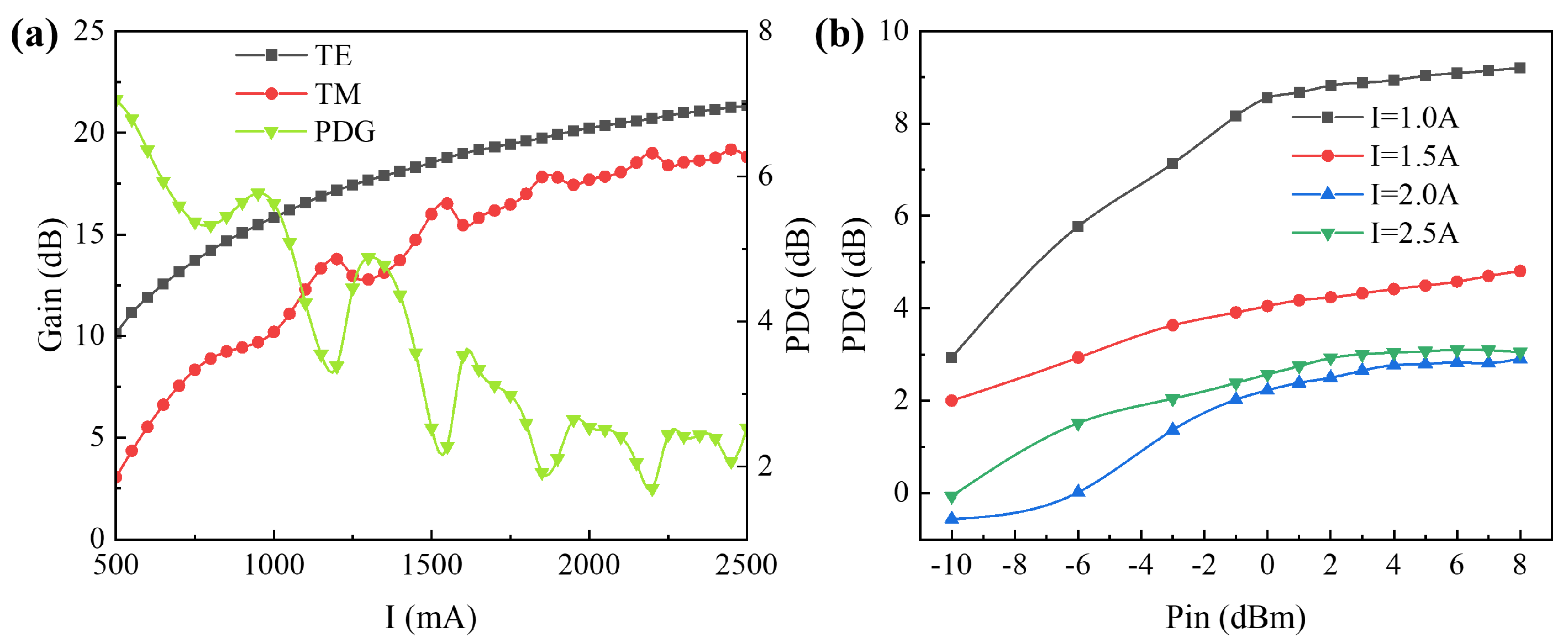
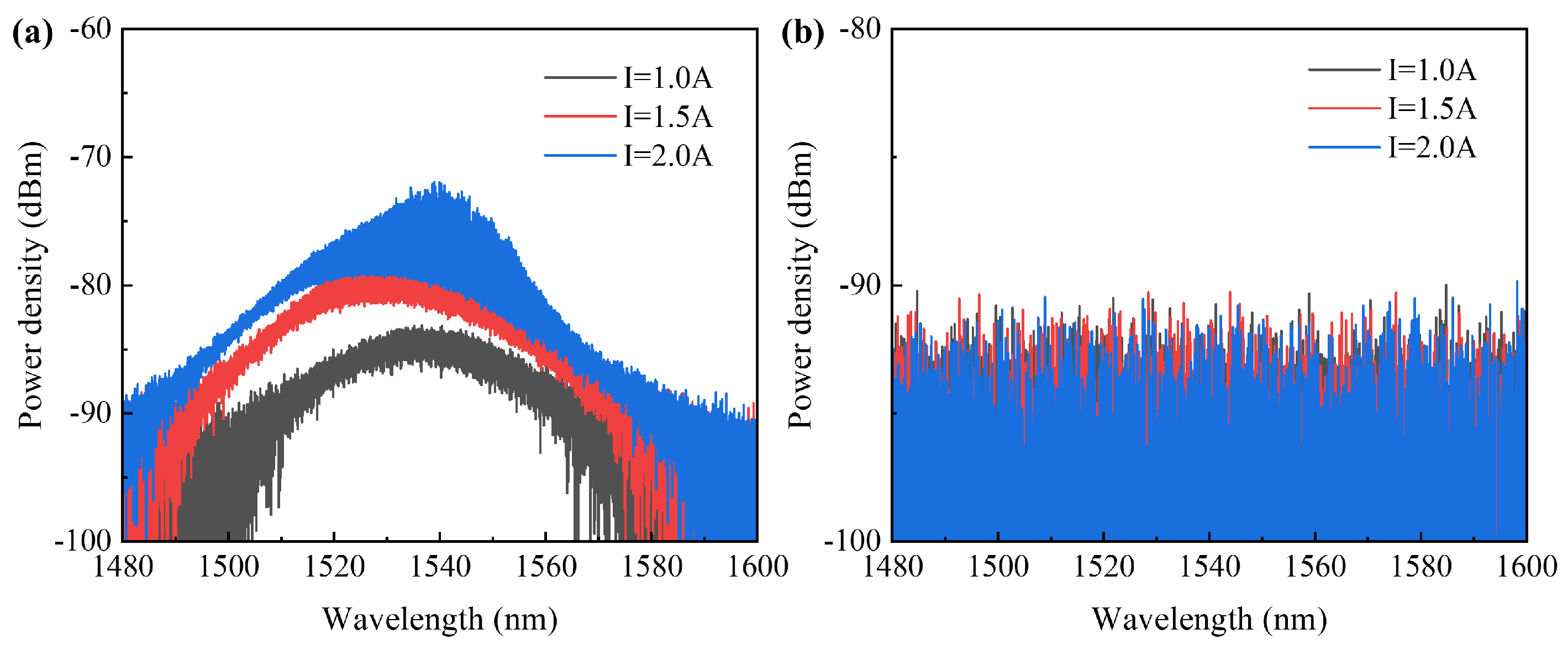
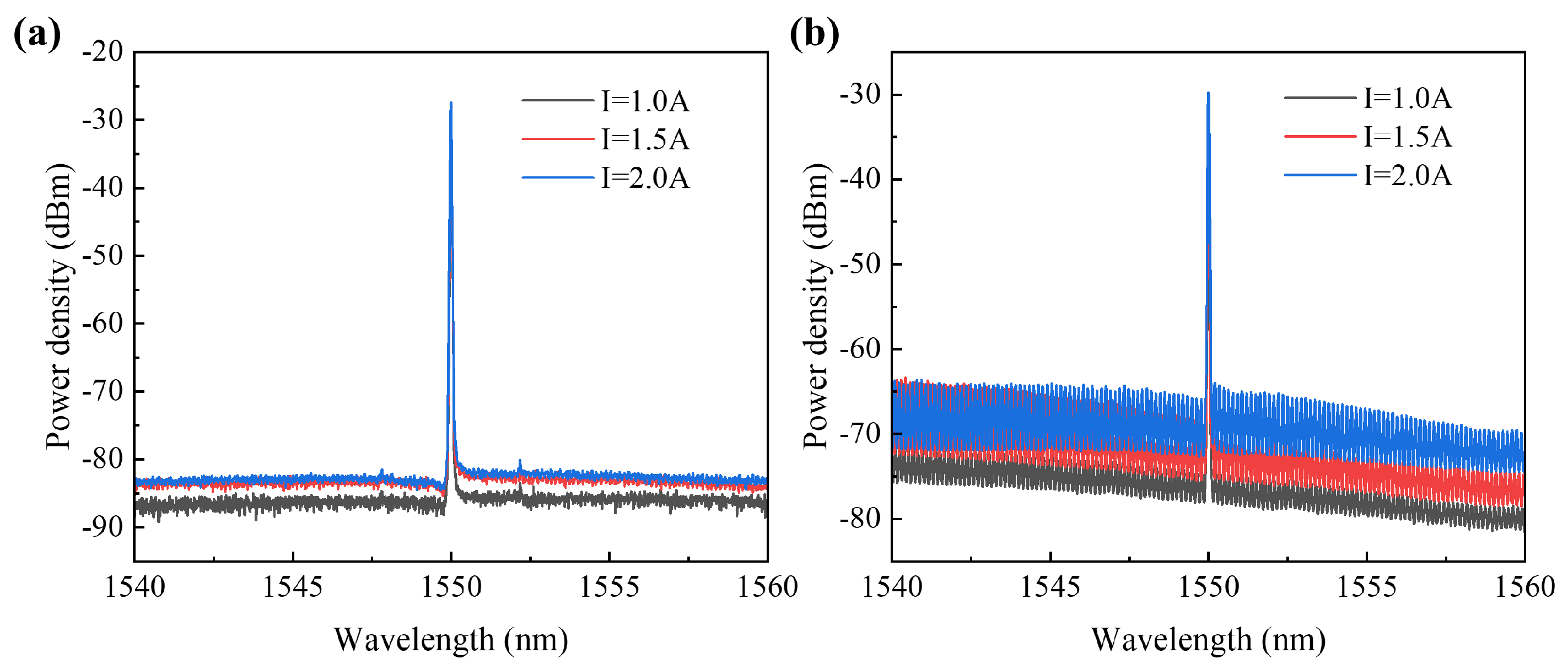
| Layer | Material | Repeat | Thickness (nm) | Doping Concentration |
|---|---|---|---|---|
| 16 | GaInAs | / | 200 | p-Zinc |
| 15 | GaInAsP | / | 50 | p-Zinc |
| 14 | InP | / | 100 | p-Zinc |
| 13 | InP | / | 1500 | p-Zinc |
| 12 | GaInAsP | / | 20 | p-Zinc |
| 11 | InP | / | 50 | p-Zinc |
| 10 | AlGaInAs | / | 60 | p-Zinc |
| 9 | AlGaInAs | / | 60 | Undoped |
| 8 | AlGaInAs | / | 10 | Undoped |
| 7 | AlGaInAs | 5 | 6 | Undoped |
| 6 | AlGaInAs | 5 | 10 | Undoped |
| 5 | AlGaInAs | / | 60 | Undoped |
| 4 | AlGaInAs | / | 60 | n-Silicon |
| 3 | AlGaInAs | / | 10 | n-Silicon |
| 2 | InP | / | 500 | n-Silicon |
| 1 | InP | / | 300 | n-Silicon |
| References | Research Unit | I1/I2 (A) | Output Power (mW) | Gain (dB) | Linewidth Expansion |
|---|---|---|---|---|---|
| Ref. [23] | Rose Hulman Inst Technol | 0.3/4.0 | 400 | ~16.4 | No test |
| Ref. [24] | III V Lab | 0.3/3.0 | 380 | ~22.8 | No test |
| Ref. [25] | Univ Politecn Madrid | 0.5/3.5 | 300 | ~15.0 | No test |
| Ref. [26] | Univ Politecn Madrid | 0.5/3.5 | 250 | No test | No test |
| Ref. [27] | Rose Hulman Inst Technol | 0.3/3.0 | 375 | ~15.7 | No test |
| Ref. [28] | Univ Politecn Madrid | 0.3/4.0 | 380 | No test | No test |
| Ref. [29] | III V Lab | 0.3/3.0 | 630 | No test | No test |
| Ref. [30] | Univ Glasgow | 0.3/0.8 | 210 | ~9.6 | No test |
| Earlier work [31] | CIOMP | 0.3/2.5 | 419 | 26.23 | 1.15 |
| This paper | CIOMP | 0.3/3.0 | 757 | 27.32 | 1.031 |
Disclaimer/Publisher’s Note: The statements, opinions and data contained in all publications are solely those of the individual author(s) and contributor(s) and not of MDPI and/or the editor(s). MDPI and/or the editor(s) disclaim responsibility for any injury to people or property resulting from any ideas, methods, instructions or products referred to in the content. |
© 2024 by the authors. Licensee MDPI, Basel, Switzerland. This article is an open access article distributed under the terms and conditions of the Creative Commons Attribution (CC BY) license (https://creativecommons.org/licenses/by/4.0/).
Share and Cite
Tang, H.; Zhang, M.; Liang, L.; Zhang, T.; Qin, L.; Song, Y.; Lei, Y.; Jia, P.; Wang, Y.; Qiu, C.; et al. Active Region Mode Control for High-Power, Low-Linewidth Broadened Semiconductor Optical Amplifiers for Light Detection and Ranging. Sensors 2024, 24, 6083. https://doi.org/10.3390/s24186083
Tang H, Zhang M, Liang L, Zhang T, Qin L, Song Y, Lei Y, Jia P, Wang Y, Qiu C, et al. Active Region Mode Control for High-Power, Low-Linewidth Broadened Semiconductor Optical Amplifiers for Light Detection and Ranging. Sensors. 2024; 24(18):6083. https://doi.org/10.3390/s24186083
Chicago/Turabian StyleTang, Hui, Meng Zhang, Lei Liang, Tianyi Zhang, Li Qin, Yue Song, Yuxin Lei, Peng Jia, Yubing Wang, Cheng Qiu, and et al. 2024. "Active Region Mode Control for High-Power, Low-Linewidth Broadened Semiconductor Optical Amplifiers for Light Detection and Ranging" Sensors 24, no. 18: 6083. https://doi.org/10.3390/s24186083
APA StyleTang, H., Zhang, M., Liang, L., Zhang, T., Qin, L., Song, Y., Lei, Y., Jia, P., Wang, Y., Qiu, C., Zheng, C., Li, X., Chen, Y., Li, D., Ning, Y., & Wang, L. (2024). Active Region Mode Control for High-Power, Low-Linewidth Broadened Semiconductor Optical Amplifiers for Light Detection and Ranging. Sensors, 24(18), 6083. https://doi.org/10.3390/s24186083















